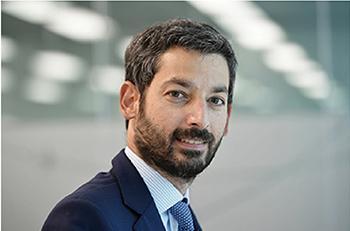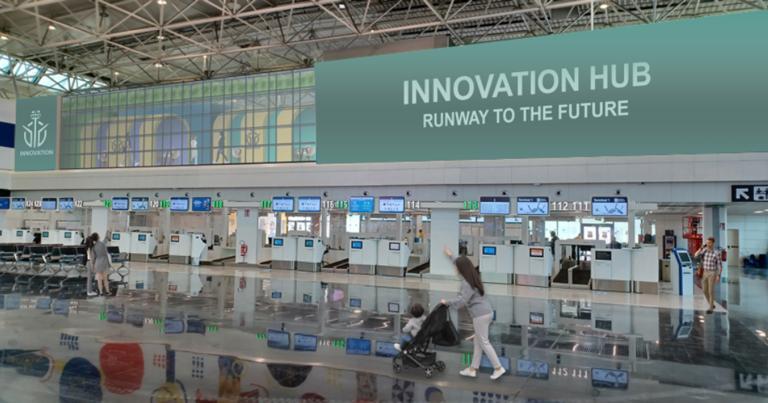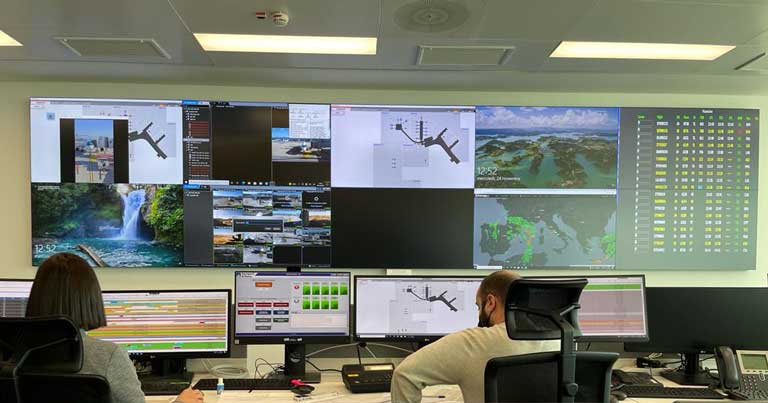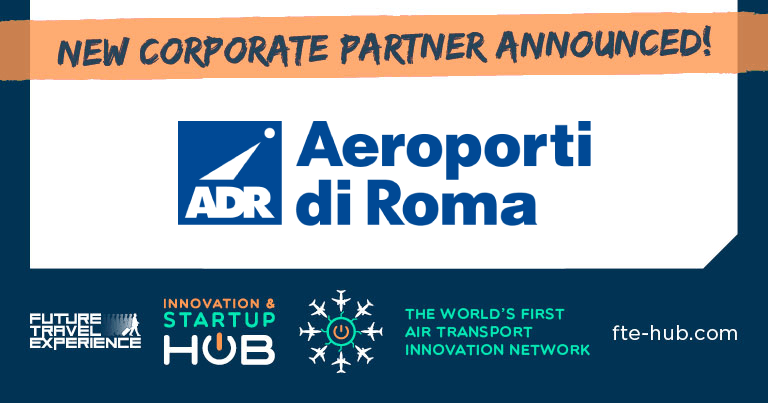How ADR’s new innovation model is driving its mission to create a “digital, reliable, data-driven and sustainable airport”
The following article was published by Future Travel Experience
Emanuele Calà, VP Innovation & Quality, Aeroporti di Roma (ADR), provides a deep dive into the airport operator’s new innovation model.
In recent years, Aeroporti di Roma (ADR) has emerged as one of the most innovative airport operators in Europe and beyond by creating a collaborative culture of innovation engaging its ecosystem of partners and the startup community. FTE caught up with Emanuele Calà, Vice President Innovation & Quality, ADR, ahead of his participation at the upcoming FTE EMEA show in Dublin on 7-9 June, for a deep dive into the company’s new innovation model, its plans for the first airport incubation hub in Italy due to open at Rome Fiumicino Airport next month, and some of the latest projects it has implemented on its journey to develop smart airport operations.
FTE: In July 2020, Aeroporti di Roma (ADR) introduced a function dedicated to innovation for the first time in its history, evolving the ADR’s ‘Quality’ business division into ‘Innovation & Quality’. What was some of the thinking behind this?

Emanuele Calà: The input came from our CEO Marco Troncone, who gave us a clear scope and dedicated team to create the new Innovation & Quality division. I was previously in charge of Quality and during that period we got a pretty unique track record of being recognised among the best airports in Europe as part of the ACI Director General’s Roll of Excellence and five times Airport Service Quality Award winner in a row. This was possible thanks to a strong collaboration within all departments of the company and heightened focus on guaranteeing an excellent passenger journey. In developing ADR’s new innovation model, we adopted the same approach, both internal and external since we strongly believe that we need to engage the whole company and its different business units.
FTE: And what about the new innovation model the company is undertaking? Can you provide a deep dive into the different actions you have implemented so far both internally and externally?
EC: ADR decided to create a new model of innovation with the aim of supporting the company in emerging from the crisis as quickly as possible, with the explicit mission of developing a digital, reliable, data driven and sustainable airport. Among these four main objectives, there is a main focus on sustainability and new revenue opportunities. After defining the objectives, we then worked on an action plan based on three main workstreams:
- Internal organisation: In the period before the pandemic, ADR had developed several successful initiatives but they had been created in a spontaneous and autonomous way by the different business units. Therefore, we considered it important to define a clear internal organisation, with well-structured roles and processes, with the aim of improving the management of ideas from the initial phase to the implementation phase. For this reason, we created for the first time a department dedicated to the management of the innovation funnel, an innovation committee chaired by our CEO and the innovation cabin crew, a group of 30 innovation ambassadors, each representing a business unit. Together these three structures are responsible for the development and implementation of innovative projects.
- Open innovation: Once the internal organisation was defined, it was essential to create the conditions to be able to develop projects with the contribution of startups. We worked to adapt the company to the needs of startups and to find the best channel to be able to engage with them. For this reason, in September 2021 we launched an international call for ideas focused on the following key areas – operations, digital experience, e-commerce and sustainability. Today we have come to the end of this path with 10 startups selected from all over the world that from next week will be part of an acceleration programme for the development of Proof of Concepts, that we will host in our innovation hub due to open at Terminal 1 of Fiumicino Airport next month.
- Ecosystem of partnerships: We truly believe that it is not possible to achieve the sustainable development goals of the industry alone. Therefore, we have launched several partnerships with leading national companies in the energy and digital sectors, and we have also launched the “Airports for Innovation” network, with the aim of collaborating with other airports to identify innovative solutions aimed at facilitating the energy and digital transition of the industry, with the common goal of having the passenger at the centre of our joint strategy.
FTE: That’s a fascinating overview of ADR’s transformation. You mentioned the first airport incubation hub in Italy, due to open at Rome Fiumicino Airport in June. Could you please provide some more details on the role of the incubation hub? And what could startups expect from the space?

EC: The hub will be our home in terms of innovation. It’s a vertical incubator dedicated to all the technology that can be based and tested inside a smart city such as an airport. It will host two batches of calls for ideas each year and for its opening in June we will host 10 startups. The space, over 600 sqm, is designed for the startups and would allow them to test and experiment their products together with ADR’s teams, having the passengers just a couple of meters away.
FTE: It is evident that ADR is leading the way in terms of innovation within the industry. So, what have been the main projects that the ADR Innovation & Quality division has introduced in the past couple of years?
EC: ADR has always been an innovative organisation and after the pandemic we focused on fostering the decarbonisation of the industry and developing an even more digital and seamless experience. To give you some examples, with the aim of reducing CO2 emissions, we set the goal of net zero carbon emissions by 2030, 20 years ahead of the target defined by the industry. We guaranteed the supply, for the first time in Italy, of sustainable aviation fuels (SAF) in Rome Fiumicino thanks to the agreement with Eni, which is the leading Italian operator in the refining and distribution of petroleum products. In 2022, ITA Airways will be able to manage two full routes with the use of green fuel thanks to this collaboration. In 2021, we obtained funding from the European Union for the development of an electric storage system based on the use of second-life batteries. This project, in partnership with ENEL X and the Fraunhofer Institute, will allow us to make the most of the solar farm that we will build by 2026, accumulating solar energy by day to be used at night, increasing our percentage of energy needs provided by renewable resources. In 2021, we also launched a fully end-to-end contactless experience (the same experience in Atlanta and in Rome airports) on a transatlantic route that allows passengers to go through security and board automatically with facial recognition thanks to biometrics technology.
FTE: Aeroporti di Roma also launched an Airport Operation Control Center to centralise operational data and provide awareness of everything happening throughout its ecosystem. Could you please provide some more details of the project and what have been the key benefits?

EC: To have a centralised control room surely makes the difference both in terms of optimisation of operations and timing to react. Our operation model is pretty unique, and the complexity can reach a considerable level. This project, led by ADR’s Chief Aviation Officer Ivan Bassato is not just a leverage in terms of technology but also on collaborative approach and the usage of data as well. The APOC, Airport Operation Control Center, constructed with a total investment of over €20 million, partly financed by the European Union, occupies an area of approximately 1,900 sqm and is equipped with state-of-the-art technological systems, designed to guarantee operational continuity even in the event of critical issues and any cyber security attacks. The planning and efficiency of airport operations will be optimised and the necessary promptness of response to unforeseen events will be ensured.
FTE: ADR recently joined the FTE Innovation & Startup Hub as a Corporate Partner. What are your main aims and expectations from the membership?

EC: We see this collaboration as a key factor to our success since we strongly believe that only by sharing our approach, failures and lesson-learned we can fine tune our model and at the same time extend our network for innovation to other airports. This partnership is a key for us to extend even more our open innovation approach, having the passenger always in the centre of our projects and developments with the industry’s stakeholders and startups from all around the world.
Article originally published here:
How ADR’s new innovation model is driving its mission to create a “digital, reliable, data-driven and sustainable airport”
from Future Travel Experience https://ift.tt/0lcJ47h
Comments
Post a Comment